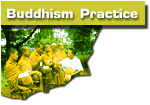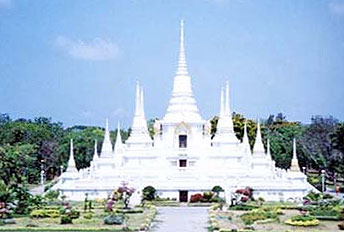 |
BANGKOK
|
||||||||
CENTRAL
|
||||||||||||
NORTHEASTERN
|
||||||||||||||
NORTHERN
|
||||||||||||
SOUTHERN
|
||||
 |
| A GUIDE TO MEDITATION CENTRES IN THAILAND |
| CENTRAL - WAT ASOKARAM |
|
MEANING
OF NAME : |
"Monastery of no sorrow" |
ADDRESS : |
Sukumvit Road, Samut Prakan 10280 |
DIRECTIONS : |
Located
32 km south of Bangkok off Hwy. 3. Many city buses in Bangkok (including
air-conditioned #7 and 8, and non-air #25, 142, 145) go to Samut Prakan;
from here you can take either of 2 local buses or a taxi 6 km farther
to the temple. Some buses between Bangkok's Eastern (Ekamai) Bus Terminal and Chonburi go via Samut Prakan; ask to be let off at Wat Asokaram (between KM 31 and 32 posts on Hwy. 3), then walk or take a samlor about 1 km south. You can see the spires and multi-tiered roof of the viharn from the highway. (People often use the name "Pak Nam" for Samut Prakan.) |
TELEPHONE : |
0-2395-0003 |
MEDITATION
SYSTEM : |
Anapanasati is the main technique taught, though meditators are free to choose their own techniques |
TEACHING
METHOD : |
Discourses are given each evening. (Meditation practice receives much emphasis in the Dhamma talks.) Teachers are available for questions. |
TEACHERS : |
Ajahn Tong (Phra Khru Suvandhamma chote), abbot (Thai; age 58) Other senior monks assist. Phra Ajahn Bunku Anuvathano (Thai; age 62) speaks good English. |
LANGUAGE : |
A few monks and nuns can speak English; the abbot does not. |
DESCRIPTION : |
Rural setting on the coast; 120 rai (50 acres). Many species of birds, some nesting, inhabit the trees on shore and on the tidal flats. Lots of crabs, mud skippers, snakes, and mosquitos live here too. Fairly quiet (except for the birds). Main buildings, such as the viharn (main hall), ched (stupa), bot (uposatha hall), women's chanting hall, and kitchen are on the shore; most kutis (huts) sit atop pilings out over the tidal flats. The magnificent viharn contains a large Buddha image, paintings, and carved wooden doors; large group meetings and monks' chanting take place in the main (upper) hall, smaller meetings are held on the middle level, and the monks' eating area is on the lower level. |
SIZE : |
monks
90-140 novices 10-15 nuns about 130 laymen about 15 laywomen about 60 |
DAILY
ROUTINE : |
About
7.15 a.m. pindabat; 8 a.m. the meal; 9.15 a.m.morning chanting; 4 p.m. afternoon chanting; 8-10 p.m.evening chanting, discourse, and meditation. On wan phra and day before and after, meditation is also held 3-5 p.m. |
FOOD
: |
Good quality and variety. Monks and novices have one meal in morning; nuns and laypeople eat once or twice in the morning. Monks and novices can go on pindabat inside or outside the temple; the kitchen and supporters supply most food. |
ACCOMMODATIONS : |
Monks, novices, and laymen stay in kutis on the west side; nuns and laywomen have kutis on the east side.Most kutis have screens and a bathroom with running water (some western-, some Thai-style); all have electricity. |
WRITE
IN ADVANCE? : |
Not necessary. It's good to have a letter of recommendation, however. |
OTHER
INFORMATION : |
A temple built in
ancient India by Emporer Asoka inspired the name of Wat Asokaram.
Ajahn Lee Dhammadharo (1906-1961), a disciple of Ajahn Mun, founded
the temple in 1955. At the request of lay followers, the uncremated
remains of Ajahn Lee Dhammadharo have been kept in a coffin in the
glassed-in shrine area upstairs in the viharn. A ceremony dedicated
to the former abbot attracts many people to the wat on 24-26 April;
teachers present discourses on mind training in the Ajahn Mun tradition. |
| Select here : |
|
|
